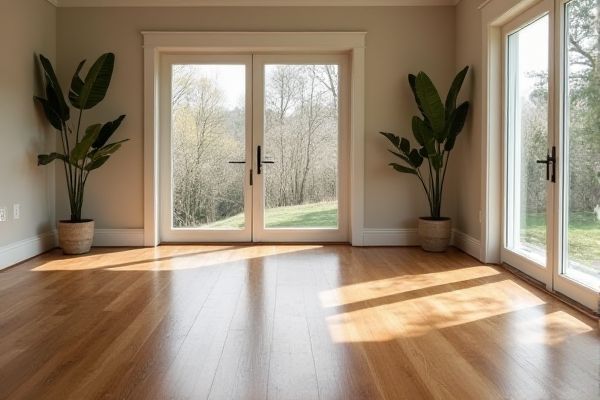
Low-maintenance flooring offers durability and ease of care, resisting scratches and moisture better than traditional wood flooring, which requires regular sealing and refinishing to maintain its appearance. Explore this article to discover which flooring option best suits your lifestyle and enhances your home's value.
Table of Comparison
| Feature | Low-Maintenance Flooring | Traditional Wood Flooring |
|---|---|---|
| Material | Vinyl, laminate, engineered wood | Solid hardwood |
| Durability | Highly resistant to scratches and moisture | Prone to scratches and water damage |
| Maintenance | Easy cleaning, no refinishing needed | Requires regular polishing and refinishing |
| Lifespan | 10-25 years depending on quality | 25-100 years with proper care |
| Installation | DIY-friendly, click-lock systems common | Requires professional installation |
| Cost | Lower upfront cost | Higher initial investment |
| Appearance | Variety of designs, can mimic wood | Natural wood grain and texture |
| Environmental Impact | Often made with synthetic materials | Renewable resource if sourced responsibly |
Introduction: Understanding Flooring Options
Low-maintenance flooring options, such as luxury vinyl plank or laminate, offer durability and easy upkeep compared to traditional wood flooring, which demands regular sanding, sealing, and polishing to maintain its appearance. These modern materials resist scratches, stains, and moisture, making them ideal for busy households or commercial spaces where time and effort for maintenance are limited. Choosing low-maintenance flooring preserves your investment by minimizing repair costs and keeping your floors looking pristine with minimal effort.
What Is Low-Maintenance Flooring?
Low-maintenance flooring refers to materials such as luxury vinyl, laminate, and engineered wood designed to withstand heavy foot traffic, resist stains, and require minimal cleaning compared to traditional hardwood. Unlike traditional wood flooring, which often demands regular sanding, polishing, and sealing, low-maintenance options provide durability with simple upkeep like sweeping or mopping. These floors combine aesthetic appeal with practicality, making them ideal for busy households and commercial spaces.
Traditional Wood Flooring: Classic Appeal and Challenges
Traditional wood flooring offers timeless elegance with natural grain patterns and warm tones that enhance home aesthetics. However, it demands regular maintenance such as sanding, polishing, and protection against moisture and scratches to preserve its appearance. Compared to low-maintenance options like vinyl or laminate, traditional wood floors require more effort and cost over time to maintain durability and beauty.
Durability: Which Flooring Lasts Longer?
Low-maintenance flooring options such as luxury vinyl plank (LVP) and laminate are engineered to resist scratches, moisture, and wear, often lasting 15 to 25 years with minimal upkeep. Traditional wood flooring, particularly hardwood species like oak or maple, can last over 50 years but requires regular maintenance including refinishing and protection from moisture damage. In terms of durability, hardwood offers longer lifespan potential, while low-maintenance flooring provides greater resistance to wear and environmental factors with less ongoing care.
Maintenance Needs: Cleaning and Upkeep Compared
Low-maintenance flooring requires minimal cleaning and upkeep, often only needing regular sweeping or damp mopping to stay in good condition, whereas traditional wood flooring demands frequent polishing, refinishing, and careful protection from moisture and scratches. Your low-maintenance options, such as vinyl or laminate, resist stains and wear better than wood, which can deteriorate over time without consistent care. Investing in low-maintenance flooring significantly reduces the time and effort spent on maintenance compared to traditional wood floors.
Cost Analysis: Initial Investment and Long-Term Value
Low-maintenance flooring options such as luxury vinyl and laminate generally require a lower initial investment compared to traditional hardwood, which includes higher costs for materials and professional installation. Over time, low-maintenance flooring offers superior cost efficiency due to reduced repair, refinishing, and upkeep expenses, while hardwood demands regular maintenance like sanding and sealing that increases lifetime costs. Considering long-term value, low-maintenance flooring delivers a more budget-friendly solution without sacrificing durability or aesthetic appeal.
Aesthetic Differences: Style and Design Flexibility
Low-maintenance flooring, such as luxury vinyl or laminate, offers greater design flexibility with a wide range of colors, patterns, and textures that can mimic natural wood, stone, or tile while resisting scratches and stains. Traditional wood flooring provides a timeless, authentic aesthetic with rich grain patterns and natural color variations that enhance the warmth and character of any space. The choice depends on whether you prioritize the realistic texture and natural beauty of wood or the versatile, customizable look combined with ease of care found in low-maintenance alternatives.
Environmental Impact: Sustainability Considerations
Low-maintenance flooring options such as luxury vinyl or bamboo often offer improved sustainability due to their longer lifespan and use of rapidly renewable materials compared to traditional hardwood, which relies on slower-growing trees and extensive resource use. Your choice of flooring can significantly reduce environmental impact by opting for products with recycled content and certifications like FSC or GREENGUARD that ensure responsible forestry and low emissions. These sustainable flooring solutions minimize waste and promote eco-friendly practices while maintaining durability and aesthetic appeal.
Installation Process: Ease and Time Requirements
Low-maintenance flooring typically offers a quicker and simpler installation process compared to traditional wood flooring, often featuring click-lock or peel-and-stick methods that reduce labor and time. Traditional wood flooring requires precise acclimatization, nailing or gluing, and finishing steps, which can extend installation time and demand professional skill. If you seek minimal disruption and faster setup, low-maintenance options can significantly streamline your flooring project.
Choosing the Best Flooring for Your Lifestyle
Low-maintenance flooring options like luxury vinyl plank and laminate offer durability and easy cleaning, making them ideal for busy households or pets. Traditional wood flooring provides timeless elegance and can increase home value but requires regular upkeep such as polishing and moisture control. Selecting the best flooring depends on lifestyle factors including activity level, budget, and desired aesthetic.
 homyna.com
homyna.com